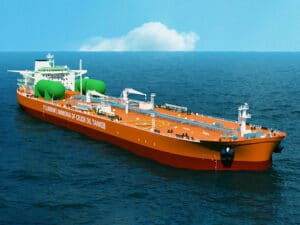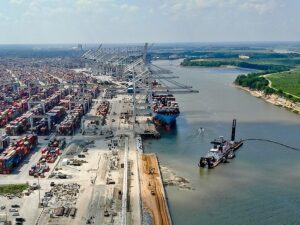
DNVGL: 2020 Global sulfur cap causing paradigm shift
Written by Marine Log Staff
Jan Hagen Andersen, Business Development Director, DNV GL Maritime
By Jan Hagen Andersen, Business Development Director, DNV GL Maritime
AUGUST 22, 2018 — The introduction of the new global sulfur cap in 2020 is causing nothing short of a paradigm shift in marine fuel. It is more than just another regulation — it is a complex challenge, and how you choose to comply may ultimately impact the future competitiveness of your assets. There is a great deal of uncertainty related to enforcement, fuel availability and technological solutions.
It is challenging to make exact predictions regarding the most cost-efficient approach. DNV GL has compiled and thoroughly analyzed available information to give shipowners a comprehensive overview of the various compliance options. Depending on the underlying assumptions, the calculations lead to different conclusions. DNV GL has established scenarios that can be used as a guidance for investment decisions. Needless to say, any unexpected event, such as volatile changes of fossil fuel prices, can substantially change the outcome.
The status quo
Emission Control Areas (ECAs) in European and North American waters already impose a 0.1% sulfur limit today, and new domestic control areas are being established in ports and areas in China. Most ships switch from HFO to MGO to ensure compliance. For alternative means of compliance, regional restrictions and limitations must be taken into consideration. Factors such as suitable scrubber technology, scrubber wash water dischargel and availability of specific fuels need to be evaluated.
Looking towards 2020, it is challenging to make precise predictions of the future fuel availability and its pricing. The refinery industry will carefully evaluate its future production capacity investments by examining the market expectations and the demand. Shipowners on the other side, tend to assume that refineries will be able to provide enough of the compliant fuel to satisfy the increased demand. The researchers and industry experts do not seem to agree either. A 2016 IMO study indicates that the refining capacity will be sufficient to provide adequate quantities of low-sulfur marine fuel by 2020. There are other sources however, which are more skeptical, pointing to the fact that desulfurization is technically difficult, costly and may discourage refineries from such investment. All of those different opinions and strategies trigger off a lot of uncertainty.
Enforcement of the sulfur cap comes with new requirements. EU member states will be obliged to check 10 per cent of all ships calling at their ports for compliance with the EU Sulfur Directive. There are also reporting duties related to fuel sample analyses and surveys. In order to raise awareness of the sulfur control issues, inspectors and crews will have to be appropriately trained. Enforcement on the high seas is still an open question.
New IMO guidance
In July this year, a working group met to develop guidelines and amendments to MARPOL Annex VI to ensure a consistent implementation of the global 0.5% sulfur cap in 2020. This meeting resulted in the finalization of the new Guidance on the development of a ship implementation plan for the consistent implementation of the 0.50% sulfur limit under MARPOL Annex VI. The guidance includes sections covering:
- Impact on fuel and machinery systems
- Flag state survey and certification
- Port State Control
- In-use fuel oil samples
- Fuel oil non-availability
- Safety implications related to blending fuels
The Ship Implementation Plan is expected to be finalized by MEPC 73 in October 2018 and issued as a Circular.
At the same meeting, work also progressed on developing a range of other guidances, for example: on the impact on fuel and machinery systems resulting from new fuel blends or fuel types; verification issues and control mechanism and actions, including Port State Control and samples of fuel oil used onboard; a standard reporting format for fuel oil non-availability; and the safety implications relating to blended fuel options.
The options
There is no one-size-fits-all solution, and the best option very much depends on vessel type, size of vessel, operational patterns and which fuels are available in the short and long term. For options requiring a retrofit, it is also important to consider the complexity of installation, possible off-hire and the remaining lifetime of the ship. Another question in the feasibility equation is the proportion of time a vessel spends inside the ECAs. Furthermore, there is also an element of the fuel consumption which partly defines the attractiveness of the ship in the charter market.
HFO with SOx scrubber
HFO will still be an option after 2020. This might be an alternative for owners who are concerned about price increase and availability of compliant fuels. However, to be in compliance, it will require the installation of exhaust gas cleaning technology commonly known as SOx scrubbers., The installation of a scrubber could be complex, especially for retrofits. There is a significant investment cost and there will also be operational expenses related to maintenance, increased power consumption, need for chemical consumables and sludge handling.
There are two technologies available today: dry and wet systems. The wet systems are by far the most predominant. Within the wet systems there are three alternatives: open loop, closed loop and a hybrid system that can operate either as a closed- or open loop system. In addition, one can choose between multi-inlet scrubbers, allowing for exhaust from more than one emission source or a single-inlet scrubber that serve only one engine. The optimal scrubber type for a given ship depends on the machinery configuration, operational profile and the routes of the vessel, such as time spent inside/outside areas and harbors with restrictions against wash water discharge. In addition, there are weight and space considerations that have to be taken into account, especially for retrofitting on existing vessels.
In the long run, if the price difference between high and low sulfur fuels is high and maintenance proves to be manageable, scrubbers may become a widespread technology.
Distillates
Switching to distillate fuel will mean a significant increase in fuel cost and may also require upgrading to the fuel treatment plant due to the significantly lower viscosity of the fuel.
New low sulfur fuels (0.5% S)
Low sulfur compliant hybrid fuels are expected to become available, as refineries gear up their plants. De-sulfurization is costly and refineries may opt to refine higher grade fuels rather than invest in de-sulfurization
systems. Typical issues with the SECA blends have been that they are more sensitive to storage, handling and compatibility.
Diligent use and handling of these types of fuel are important for successful operation. Quality control when bunkering to ensure that on-spec fuel is received will also be important.
LNG as ship fuel
Among the alternative fuels, LNG will probably get more traction as availability and bunkering infrastructure improve. This however, applies mainly to the newbuild tonnage, especially for ships which will operate extensively within NOx ECA regions. Beyond being a sulfur-free fuel, LNG also offers a reduction in NOx emissions particulate matter and CO2 footprint compared with conventional fuels. Given the present regulatory outlook, these fuel characteristics will probably become more and more attractive in the future.
We are already seeing some interesting projects that feature LNG as fuel. Most notably perhaps, in the cruise sector where there are an increasing number of cruise ships under construction that have the option of using LNG as ship fuel. One of the most recent examples is the AIDA Prima, which uses LNG in port. In addition, the Royal Caribbean Cruise Lines have ordered two cruise vessels, which will be powered by LNG and fuel cells. The ships will be built at the Finnish yard Meyer Turku and are scheduled for delivery in 2022 and 2024.
Other alternative fuels
There are a variety of emerging fuels that could be options for the future. The most predominant are methanol, different types of biofuels and LPG. These are considered to have very little impact on the market as a whole, but are alternatives that can be considered where supply is readily available. Apart from some of the biofuels, changing to these types of fuel will need special adaptive engines and fuel treatment systems.
Every ship is different and so is its operational profile. The ultimate decision between HFO and scrubber, distillate fuel (MGO), LNG, low-sulfur fuels (0.50% S) or other, alternative fuels should to be evaluated individually.
In 2020 we assume that the vast majority of ships will continue to run on whichever compliant fuel, can be supplied in a port. This will be a higher-valued product compared to conventional HFO, and thus inevitably will increase the operating costs. It is in owners’ best interest to investigate all compliance options that may increase their competitive edge.





Leave a Reply
You must be logged in to post a comment.